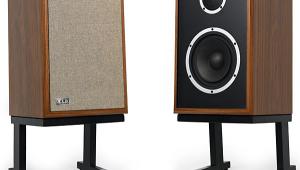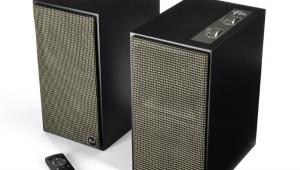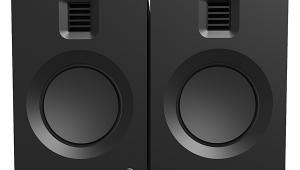Onix x-series x-ls Speaker System
Break out that dusty case of champagne. Get the kids together. Give them each a bottle. No, don't do that. But yell out the window to your neighbors. Call all of your relatives. Throw a few shrimp on the barbie. Make popcorn. Stack your favorite DVDs and CDs in neat piles next to the equipment rack. If you have symptoms lasting more than four hours, alert the media. Something momentous has happened. I have found my favorite budget speakers of all time.

When I first saw them at a trade show, the Onix x-series caught my eye instantly. I saw a bookshelf-sized speaker in glossy rosewood glowing against a fabric backdrop. The thing practically demanded that I take a picture and post it to my blog. I did, but, still, I was in doubt. A pretty face is nice. But what would these speakers sound like?
They arrived at my place in soft white flannel bags, which revealed fascinatingly marbled wood grains underneath. As it turned out, the rosewood versions were "hard to get," I was told. Regardless, the light-maple-veneer finish I got instead was too good to be true for a $110 speaker. The enclosures' rounded edges felt good in my hands as I hoisted the speakers onto stands and fed my speaker cables' banana plugs into the binding posts.
When I turned on my receiver, I wasn't expecting much. Surely, a speaker that sells for less than the apparent value of its enclosure must sound bad. Instead, when I fed it a symphonic CD, it sounded pleasant—maybe a little better than pleasant. Then came a huge mistake—I started playing vinyl. The notebook gathered dust on my desk, so I don't recall much of what happened over the next few days, which luckily coincided with a weekend. But I sure had a great time.
A Fine Pedigree
As a brand, Onix dates back to the late 1970s. They have a fine English pedigree and were once best known for their two-channel amps. An ancient Onix OA21s integrated stereo amp still serves on my desktop. But Colorado-based Perpetual Technologies now owns the brand. The x-series is one of the company's five speaker lines. The others, all higher priced, are the Focus Line Source, Reference, Rocket, and Strata series.
The Onix x-ls is a chunky stand-mount speaker of more than a foot in height and depth. A braced enclosure of 0.75-inch medium-density fiberboard contributes the lion's share of its 17 pounds. It is designed for use as both a satellite and a center. A system with five matched speakers and a sub goes for $747. If you'd prefer a horizontal center, which has an extra woofer, the price goes up to $776 for a 5.1-channel system. If you use the dual-woofer speaker all around, the price reaches $894. With Onix stands, all these prices tip over $1,000. The speakers are available at www.avi123.com with a 30-day money-back guarantee.
Sporting a conventional two-way, ported design, the x-ls features a 1-inch treated-fabric dome tweeter and a custom-made 6.5-inch paper cone woofer with a vented pole piece. The cone is treated with plastic, giving it a shiny black finish. The woofer utilizes a polymer chassis, as opposed to the pressed or cast metal used in most speakers. While this might save a buck, Onix says it prevents transmission of resonances to the front baffle. The speaker grille follows the shape of the drivers, leaving much of the beautiful baffle exposed. I ran the speakers with the grilles off in the front to coax a little more detail from the warm balance.
The x-cs served occasionally as a center speaker for this review, although the LCR design could serve all channels. It comes in a sealed enclosure that is 20 inches long—more than 2 inches greater than the largest dimension of the subwoofer's cabinet. The x-sub comes in a tall and narrow front-ported enclosure with the 8-inch woofer firing down onto a pedestal, so it won't be muffled if you plop it onto a carpeted floor. Onix says the slot-shaped and folded port reduces undesirable noise, which is especially critical when the port is potentially firing directly at the listener, as it was during my review. Announced, but not available at the time of this review, is a floorstanding model, the x-sls tower, with the same driver complement as the x-ls but in a larger enclosure tuned for deeper bass response.
Despite the weight of the x-ls, you can wall-mount it using the x-ls LaunchPad ($20 per pair). It bolts to four threaded sockets already built into the bottom of each speaker. The LaunchPad plate does not include a wall bracket—Onix recommends models from OmniMount.
However, you'll get better results if you place the speakers on stands a few feet out from the wall. Onix offers the x-ls custom speaker stand, which is made of tubular steel and stands either 24 or 30 inches high, for $149 per pair. If you're on a tight budget, less expensive metal or particleboard stands are available from many sources, but the Onix stand is designed to take advantage of the speaker's threaded sockets.
My review system included my Rotel RSX-1065 receiver, Integra DPS-10.5 universal disc player, Rega Planar 25 turntable, Shure V97xE cartridge, and NAD phono preamp.
Front Loaded
Since my review experience was front-loaded with orchestral and chamber music, I soon had a good idea of how the system sounded. Uncolored it was not. Benignly warm it was. This was more a matter of smoothness than sweetening. String sections were the main beneficiaries. From the violins down to the basses, the x-series had them covered. The fabric tweeters delivered a little less tang in the brass and less definition in the reeds than I'm used to hearing. But I was delighted to be relieved of the ringing that often sucker-punches me—even with many otherwise high-performing speakers—when I try to enjoy an orchestra's or a pianist's full dynamic range. The flaws of historical (and just plain bad) recordings were still audible but soft-pedaled. That in turn influenced what I chose to play: I stopped worrying about technicalities and went for musical merit.
My strongest memories of the x-series speakers, oddly enough, were with two works that form the basis of many orchestral movie soundtracks: The Planets and The Rite of Spring. If you listen to Star Wars, you're hearing a slick recycling of themes from The Planets by Gustav Holst. William Steinberg's early-1970s recording with the Boston Symphony sets glittering textures in a black sky of reverb. The Onix speakers delivered a silky-smooth account of the fearsome resolution available in this audiophile-quality recording. That I was listening to an ancient foil-jacket Deutsche Grammophon LP, bought after hearing it in a college roommate's collection, only enhanced my pleasure.
Igor Stravinsky himself conducted the 1960 recording of The Rite of Spring that grabbed me by the neck during my lost weekend. The close-miked recording can be abrasive, but the Onix system softened its rough edges, leaving me free to contemplate the composer's authoritative voicing and blending of this violent work's melodic shards and jostling rhythms. I'd never gotten so much pleasure from my "six eyes" LP (a reference to the historic Columbia logo).
Guitarist Martin Carthy and fiddler Dave Swarbrick return for Straws in the Wind. Onix's warm presentation bathed the soundstage in a golden glow, keeping the fiddle's cutting edge from overwhelming its woody sweetness and throwing a gentle spotlight on Carthy's rhythmically unorthodox acoustic guitar. "Mrs. Marriott" was sheer brilliance, not only for Swarb's unpredictable melodic turns, but also for the way Carthy kept up with them.
Crude live recordings also benefited from the Onix touch. The latest David Gilmour CD single—with covers of two Syd Barrett songs—lost some of its digital harshness. That enabled me to relax and enjoy "Arnold Layne," with guest vocals by David Bowie and a psychedelic rave-up organ solo by original Pink Floyd member Richard Wright. Gilmour's aching solo acoustic performance of "Dark Globe" gave me a (probably expensive) seat in the audience, making the best of the big-arena sound.
Attack Fearlessly
Attack Force is a Steven Seagal movie—I could stop right there, couldn't I?—in which the star is seen mostly with his pouchy face half in shadow, head tilted, mouthing portentous lines. He's not just an autumnal action hero but a nearly immobile one. Gunfire behaved peculiarly like an orchestra in this mix, always exploding in the front channels and decaying in the back. The persistent all-channel placement of other effects and music made everything rain down predictably in the middle of the room, although, thanks to the system's gentle midrange, having all that activity a few feet from my knees wasn't off-putting.
Dialogue was intelligible and pretty consistent both on and off axis—but consonants seemed to be on the soft side. The problem was ameliorated when I hiked the master volume, and the subsequent volume peaks didn't hurt my ears. These speakers like lots of power. The x-ls has a rated sensitivity of 87 decibels (1 watt/1 meter), which is a bit on the low side. Onix says the x-cs' sensitivity is 90.5 dB under the same conditions, allowing the dialogue and the leading edge of effects to cut through more easily with a lower master-volume setting.
Fearless, a Jet Li martial-arts vehicle, reflected its unexpected emotional richness in the varying ambiences of its pounding drums. Reverberations in spaces large and small flourished. When given a submerged ambience for psychologically charged moments in action sequences, the treated drum sound panned gracefully among the identical speakers.
The bamboo flute and string orchestra were smooth and natural, especially when serving as a backdrop for rural rice-paddy scenes that quieted the heart of the story and developed Li's character. The tweeters did surprisingly well with the clanging of swords. Crowd noise, however, was slightly vague, revealing a soundfield that was large but not as strongly outlined as it would have been with some other favorite speakers. Integration of the sub was excellent, but the sub's lack of gain required a much higher setting of its level control than I'm used to.
My notebook summed up the most notable effect of The Wicker Man this way: "Bees!" The humming filled the soundfield like the evil twin of the birdsong that contributed to the deceptive peace of other scenes in this pagan horror-movie remake.
Beating the System
The possibilities in an affordable speaker purchase have now expanded beyond vinyl-wrapped enclosures. No other budget speaker series I'm familiar with provides both the beauty and value of the x-ls and family. And they sound as good as they look. There are some equally good-sounding speakers at the same price, but not many. It mystifies me how the people at Perpetual Technologies could make money (or much money) on these speakers. But one thing is clear. With the x-series, Onix may have monkey-wrenched the entire loudspeaker industry.
* Audio editor Mark Fleischmann is also the author of the annually updated book Practical Home Theater (available through www.quietriverpress.com).
Highlights
• Good value in budget speakers
• Truly high-end cabinet construction
• Smooth, engaging sound




























































